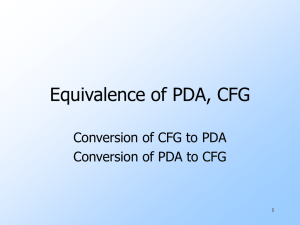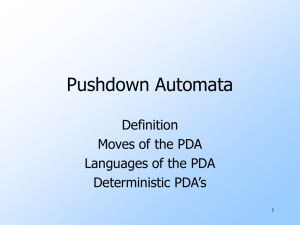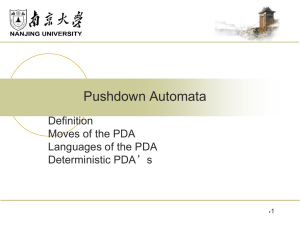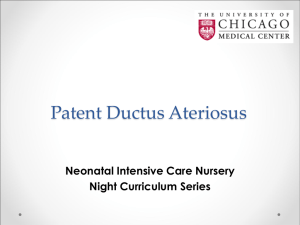Pushdown Automata
advertisement
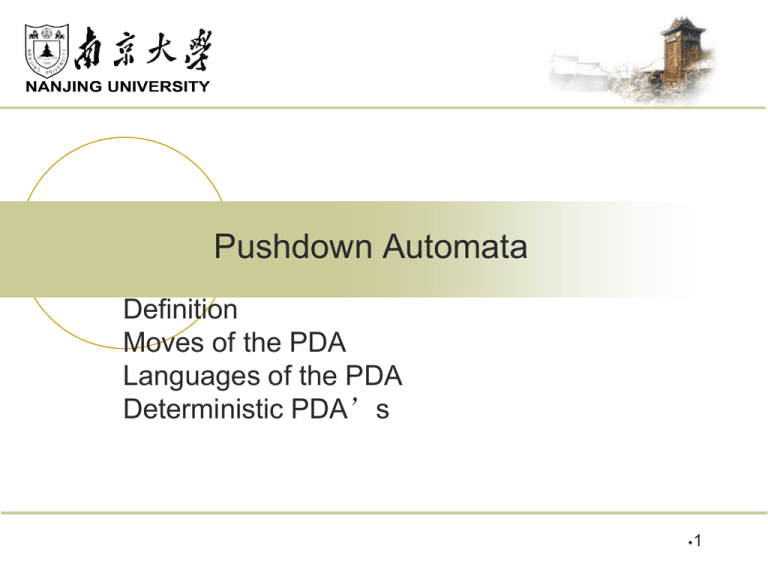
Pushdown Automata
Definition
Moves of the PDA
Languages of the PDA
Deterministic PDA’s
1
Pushdown Automata
The PDA is an automaton equivalent to the CFG in
language-defining power.
Only the nondeterministic PDA defines all the
CFL’s.
But the deterministic version models parsers.
Most programming languages have deterministic
PDA’s.
2
Intuition: PDA
Think of an ε-NFA with the additional power that
it can manipulate a stack.
Its moves are determined by:
2.
The current state (of its “NFA”),
The current input symbol (or ε), and
3.
The current symbol on top of its stack.
1.
3
Picture of a PDA
Next input
symbol
0111
q
X
Y
Z
Input
State
Top of Stack
Stack
4
Intuition: PDA – (2)
Being nondeterministic, the PDA can have a choice
of next moves.
In each choice, the PDA can:
1.
2.
Change state, and also
Replace the top symbol on the stack by a sequence of
zero or more symbols.
Zero symbols = “pop.”
Many symbols = sequence of “pushes.”
5
PDA Formalism
A PDA is described by:
1.
2.
3.
4.
5.
6.
7.
A finite set of states (Q, typically).
An input alphabet (Σ, typically).
A stack alphabet (Γ, typically).
A transition function (δ, typically).
A start state (q0, in Q, typically).
A start symbol (Z0, in Γ, typically).
A set of final states (F ⊆ Q, typically).
6
Conventions
a, b, … are input symbols.
But sometimes we allow ε as a possible value.
…, X, Y, Z are stack symbols.
…, w, x, y, z are strings of input symbols.
, ,… are strings of stack symbols.
7
The Transition Function
Takes three arguments:
A state, in Q.
An input, which is either a symbol in Σ or ε.
A stack symbol in Γ.
1.
2.
3.
δ(q, a, Z) is a set of zero or more actions of the
form (p, ).
p is a state; is a string of stack symbols.
8
Actions of the PDA
If δ(q, a, Z) contains (p, ) among its actions, then
one thing the PDA can do in state q, with a at the
front of the input, and Z on top of the stack is:
2.
Change the state to p.
Remove a from the front of the input (but a may be ε).
3.
Replace Z on the top of the stack by .
1.
9
Example: PDA
Design a PDA to accept {0n1n | n > 1}.
The states:
q = start state. We are in state q if we have seen only
0’s so far.
p = we’ve seen at least one 1 and may now proceed
only if the inputs are 1’s.
f = final state; accept.
10
Example: PDA – (2)
The stack symbols:
Z0 = start symbol. Also marks the bottom of the stack, so
we know when we have counted the same number of
1’s as 0’s.
X = marker, used to count the number of 0’s seen on the
input.
11
Example: PDA – (3)
The transitions:
δ(q, 0, Z0) = {(q, XZ0)}.
δ(q, 0, X) = {(q, XX)}. These two rules cause one X
to be pushed onto the stack for each 0 read from the
input.
δ(q, 1, X) = {(p, ε)}. When we see a 1, go to state p
and pop one X.
δ(p, 1, X) = {(p, ε)}. Pop one X per 1.
δ(p, ε, Z0) = {(f, Z0)}. Accept at bottom.
12
Actions of the Example PDA
000111
q
Z0
13
Actions of the Example PDA
00111
q
X
Z0
14
Actions of the Example PDA
0111
q
X
X
Z0
15
Actions of the Example PDA
111
q
X
X
X
Z0
16
Actions of the Example PDA
11
p
X
X
Z0
17
Actions of the Example PDA
1
p
X
Z0
18
Actions of the Example PDA
p
Z0
19
Actions of the Example PDA
f
Z0
20
Instantaneous Descriptions
We can formalize the pictures just seen with an
instantaneous description (ID).
A ID is a triple (q, w, ), where:
1.
2.
3.
q is the current state.
w is the remaining input.
is the stack contents, top at the left.
21
The “Goes-To” Relation
To say that ID I can become ID J in one move of
the PDA, we write I⊦J.
Formally, (q, aw, X)⊦(p, w, ) for any w and ,
if δ(q, a, X) contains (p, ).
Extend ⊦ to ⊦*, meaning “zero or more moves,”
by:
Basis: I⊦*I.
Induction: If I⊦*J and J⊦K, then I⊦*K.
22
Example: Goes-To
Using the previous example PDA, we can
describe the sequence of moves by:
(q, 000111, Z0)⊦(q, 00111, XZ0)⊦
(q, 0111, XXZ0)⊦(q, 111, XXXZ0)⊦
(p, 11, XXZ0)⊦(p, 1, XZ0)⊦(p, ε, Z0)⊦
(f, ε, Z0)
Thus, (q, 000111, Z0)⊦*(f, ε, Z0).
What would happen on input 0001111?
23
Answer
(q, 0001111, Z0)⊦(q, 001111, XZ0)⊦
(q, 01111, XXZ0)⊦(q, 1111, XXXZ0)⊦
(p, 111, XXZ0)⊦(p, 11, XZ0)⊦(p, 1, Z0)⊦
(f, 1, Z0)
Note the last ID has no move.
0001111 is not accepted, because the input is not
completely consumed.
24
Language of a PDA
The common way to define the language of a PDA is
by final state.
If P is a PDA, then L(P) is the set of strings w such
that (q0, w, Z0) ⊦* (f, ε, ) for final state f and any .
25
Language of a PDA – (2)
Another language defined by the same PDA is by
empty stack.
If P is a PDA, then N(P) is the set of strings w such
that (q0, w, Z0) ⊦*(q, ε, ε) for any state q.
26
Equivalence of Language
Definitions
1.
2.
If L = L(P), then there is another PDA P’ such
that L = N(P’).
If L = N(P), then there is another PDA P’’ such
that L = L(P’’).
27
Proof: L(P) -> N(P’) Intuition
P’ will simulate P.
If P accepts, P’ will empty its stack.
P’ has to avoid accidentally emptying its stack,
so it uses a special bottom-marker to catch the
case where P empties its stack without
accepting.
28
Proof: L(P) -> N(P’)
P’ has all the states, symbols, and moves of P,
plus:
1.
2.
3.
4.
5.
Stack symbol X0 (the start symbol of P’), used to guard
the stack bottom.
New start state s and “erase” state e.
δ(s, ε, X0) = {(q0, Z0X0)}. Get P started.
Add {(e, ε)} to δ(f, ε, X) for any final state f of P and
any stack symbol X, including X0.
δ(e, ε, X) = {(e, ε)} for any X.
29
Proof: N(P) -> L(P’’) Intuition
P” simulates P.
P” has a special bottom-marker to catch the
situation where P empties its stack.
If so, P” accepts.
30
Proof: N(P) -> L(P’’)
P’’ has all the states, symbols, and moves of P,
plus:
1.
2.
3.
4.
Stack symbol X0 (the start symbol), used to guard the
stack bottom.
New start state s and final state f.
δ(s, ε, X0) = {(q0, Z0X0)}. Get P started.
δ(q, ε, X0) = {(f, ε)} for any state q of P.
31
Deterministic PDA’s
To be deterministic, there must be at most one
choice of move for any state q, input symbol a, and
stack symbol X.
In addition, there must not be a choice between
using input ε or real input.
Formally, δ(q, a, X) and δ(q, ε, X) cannot both be
nonempty.
32
Equivalence of PDA, CFG
Conversion of CFG to PDA
Conversion of PDA to CFG
33
Overview
When we talked about closure properties of regular
languages, it was useful to be able to jump between
RE and DFA representations.
Similarly, CFG’s and PDA’s are both useful to
deal with properties of the CFL’s.
34
Overview – (2)
Also, PDA’s, being “algorithmic,” are often
easier to use when arguing that a language is a
CFL.
Example: It is easy to see how a PDA can
recognize balanced parentheses; not so easy as a
grammar.
35
Converting a CFG to a PDA
Let L = L(G).
Construct PDA P such that N(P) = L.
P has:
One state q.
Input symbols = terminals of G.
Stack symbols = all symbols of G.
Start symbol = start symbol of G.
36
Intuition About P
At each step, P represents some left-sentential
form (step of a leftmost derivation).
If the stack of P is , and P has so far consumed x
from its input, then P represents left-sentential
form x.
At empty stack, the input consumed is a string in
L(G).
37
Transition Function of P
1.
δ(q, a, a) = (q, ε). (Type 1 rules)
2.
This step does not change the LSF represented, but
“moves” responsibility for a from the stack to the
consumed input.
If A -> is a production of G, then δ(q, ε, A)
contains (q, ). (Type 2 rules)
Guess a production for A, and represent the next LSF in the
derivation.
38
Proof That L(P) = L(G)
We need to show that (q, wx, S) ⊦* (q, x, ) for
any x if and only if S =>*lm w.
Part 1: “only if” is an induction on the number
of steps made by P.
Basis: 0 steps.
Then = S, w = ε, and S =>*lm S is surely true.
39
Induction for Part 1
Consider n moves of P: (q, wx, S) ⊦* (q, x, ) and
assume the IH for sequences of n-1 moves.
There are two cases, depending on whether the last
move uses a Type 1 or Type 2 rule.
40
Use of a Type 1 Rule
The move sequence must be of the form (q, yax, S)
⊦* (q, ax, a) ⊦ (q, x, ), where ya = w.
By the IH applied to the first n-1 steps, S =>*lm
ya.
But ya = w, so S =>*lm w.
41
Use of a Type 2 Rule
The move sequence must be of the form (q, wx, S)
⊦* (q, x, A) ⊦ (q, x, ), where A -> is a
production and = .
By the IH applied to the first n-1 steps, S =>*lm
wA.
Thus, S =>*lm w = w.
42
Proof of Part 2 (“if”)
We also must prove that if S =>*lm w, then (q, wx,
S) ⊦* (q, x, ) for any x.
Induction on number of steps in the leftmost
derivation.
Ideas are similar; omitted.
43
Proof – Completion
We now have (q, wx, S) ⊦* (q, x, ) for any x if and
only if S =>*lm w.
In particular, let x = = ε.
Then (q, w, S) ⊦* (q, ε, ε) if and only if S =>*lm w.
That is, w is in N(P) if and only if w is in L(G).
44
From a PDA to a CFG
Now, assume L = N(P).
We’ll construct a CFG G such that L = L(G).
Intuition: G will have variables [pXq] generating
exactly the inputs that cause P to have the net effect of
popping stack symbol X while going from state p to
state q.
P never gets below this X while doing so.
45
Picture: Popping X
Stack
height
X
w
46
Variables of G
G’s variables are of the form [pXq].
This variable generates all and only the strings w
such that
(p, w, X) ⊦*(q, ε, ε).
Also a start symbol S we’ll talk about later.
47
Productions of G
Each production for [pXq] comes from a move of P
in state p with stack symbol X.
Simplest case: δ(p, a, X) contains (q, ε).
Note a can be an input symbol or ε.
Then the production is [pXq] -> a.
Here, [pXq] generates a, because reading a is one
way to pop X and go from p to q.
48
Productions of G – (2)
Next simplest case: δ(p, a, X) contains (r, Y) for
some state r and symbol Y.
G has production [pXq] -> a[rYq].
We can erase X and go from p to q by reading a
(entering state r and replacing the X by Y) and then
reading some w that gets P from r to q while erasing the
Y.
49
Picture of the Action
X Y
p r
a
q
w
50
Productions of G – (3)
Third simplest case: δ(p, a, X) contains (r, YZ)
for some state r and symbols Y and Z.
Now, P has replaced X by YZ.
To have the net effect of erasing X, P must erase
Y, going from state r to some state s, and then
erase Z, going from s to q.
51
Picture of the Action
Y
X
p
a
Z
Z
r
s
u
q
v
52
Third-Simplest Case – Concluded
Since we do not know state s, we must generate a
family of productions:
[pXq] -> a[rYs][sZq]
for all states s.
[pXq] =>* auv whenever [rYs] =>* u and
[sZq] =>* v.
53
Productions of G: General Case
Suppose δ(p, a, X) contains (r, Y1,…Yk) for some
state r and k > 3.
Generate family of productions
[pXq] ->
a[rY1s1][s1Y2s2]…[sk-2Yk-1sk-1][sk-1Ykq]
54
Completion of the Construction
We can prove that (q0, w, Z0)⊦*(p, ε, ε) if and
only if [q0Z0p] =>* w.
Proof is two easy inductions.
But state p can be anything.
Thus, add to G another variable S, the start
symbol, and add productions S -> [q0Z0p] for each
state p.
55
